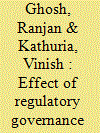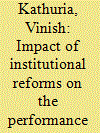|
|
|
Sort Order |
|
|
|
Items / Page
|
|
|
|
|
|
|
| Srl | Item |
| 1 |
ID:
150771


|
|
|
|
|
| Summary/Abstract |
This paper investigates the impact of institutional quality – typified as regulatory governance – on the performance of thermal power plants in India. The Indian power sector was reformed in the early 1990s. However, reforms are effective only as much as the regulators are committed in ensuring that they are implemented. We hypothesize that higher the quality of regulation in a federal Indian state, higher is the efficiency of electric generation utilities. A translog stochastic frontier model is estimated using index of state-level independent regulation as one of the determinants of inefficiency. The dataset comprises a panel of 77 coal-based thermal power plants during the reform period covering over 70% of installed electricity generation capacity. The mean technical efficiency of 76.7% indicates there is wide scope for efficiency improvement in the sector. Results are robust to various model specifications and show that state-level regulators have positively impacted plant performance. Technical efficiency is sensitive to both unbundling of state utilities, and regulatory experience. The policy implication is that further reforms which empower independent regulators will have far reaching impacts on power sector performance.
|
|
|
|
|
|
|
|
|
|
|
|
|
|
|
|
| 2 |
ID:
176736


|
|
|
|
|
| Summary/Abstract |
This paper investigates the role of corporate governance (CG) on the financial and operational (technical-cum-commercial) performance of India utilities. The Indian power sector, in the past, was mainly driven by electoral and political considerations that led to an unsustainable level of performance. The Indian Electricity Act 2003, brought a common framework of reforms at the national level. After more than fifteen years of reforms, results at the distribution end are still mixed. We argue that the ‘external causes' unleashed from the reform process should be a catalyst to more significant internal management changes. To quantify these changes, we compute the CG index and then employ data of 48 power utilities from 19 Indian states for the year 2016-17 to see the impact of this index on their performance. We find a positive relationship between the CG index and the performance of the utilities. An important policy implication is that improvement in CG is worth pursuing even in utilities where arm's length between government and the utility is not possible, as the government is the owner of these utilities.
|
|
|
|
|
|
|
|
|
|
|
|
|
|
|
|
| 3 |
ID:
181438


|
|
|
|
|
| Summary/Abstract |
The Indian power sector has seen significant institutional changes in the last two decades. After more than 20 years of reforms, the distribution segment is still incurring losses. To quantify these institutional changes, we construct a reform index and then employ data of 55 power utilities from 29 Indian states for 2007–08 to 2015–16 to see the impact of this index on their financial and technical-cum-commercial performance. This paper contributes to the literature in three ways: a) accounting for the maturity of the reforms while calculating the index, b) relying on the dynamic nature of the reforms, and c) carrying out the analysis at the utility level. We find that once the dynamic nature of the data is accounted for and utility-specific variables are controlled, the reform index influences both the financial and the technical-cum-commercial performance of the utilities. An important policy implication of the present study is that as long as the cost-reflective tariff is still prevalent, the commercial viability of utilities cannot be assured
|
|
|
|
|
|
|
|
|
|
|
|
|
|
|
|
| 4 |
ID:
121193


|
|
|
|
|
| Publication |
2013.
|
| Summary/Abstract |
Empirical studies on total factor productivity growth (TFPG) in developing countries highlight trade openness, research and development and market structure as being the most important determinants of TFPG. The role of institutions remains overlooked in the literature on the determinants of TFPG. In this article, we look into the role of institutional quality as captured by effective state-business relationships (SBRs) in influencing TFPG, using Indian manufacturing as a case study. By SBRs we mean a set of highly institutionalized, responsive and public interactions between the state and the business sector. To compute TFPG, we use firm level data for both the formal and informal manufacturing sectors. We correct for the simultaneity bias associated with the production function approach for TFPG estimation by employing a method developed by Levinsohn and Petrin. We propose measures of effective SBRs for 15 Indian states over the period 1994-2005, and then use them in TFPG equations to estimate the effect of SBR on TFPG. The results indicate that SBR has positively affected the TFPG of Indian industry. The effect, however, is primarily for the formal sector.
|
|
|
|
|
|
|
|
|
|
|
|
|
|
|
|
| 5 |
ID:
136228


|
|
|
|
|
| Summary/Abstract |
The 2003 Indian Electricity Act incentivizes captive power production through open access in an attempt to harness all sources of generation. Yet, we observe that only some firms self-generate while others do not. In this paper we give a transaction cost explanation for such divergent behavior. Using a primary survey of 107 firms from India, we construct a distinct variable to measure the transaction-specificity of electricity use. The ‘make or buy’ decision is then econometrically tested using probit model. Results are highly responsive to transaction-specificity and the likelihood of captive power generation is positively related to it. At the industrial level, this explains why food and chemical firms are more likely to make their own electricity. Since the burden of poor grid supply is highest on smaller sized and high transaction-specific firms, the grid access policies need to account for firm-level characteristics if government wants to incentivize captive power generation.
|
|
|
|
|
|
|
|
|
|
|
|
|
|
|
|
| 6 |
ID:
183739


|
|
|
|
|
| Summary/Abstract |
This article analyses the role of structural change in explaining growth accelerations and decelerations in Indian states over the 30 years from 1980–1981 to 2010–2011. We employ conventional shift-share analysis to measure the sectoral contribution to productivity growth. We apply this methodology to an eight-sector data set for 15 major states. Our results show that productivity changes ‘within’ sectors explain the considerable improvement in productivity in Indian states rather than the reallocation of labour to more productive sectors. At the aggregate level and for several states, significant contribution to productivity improvements has emanated from agriculture, trade and manufacturing sectors. In all these sectors, the main contribution emerged from within sector productivity improvements, not from structural changes. However, the reallocation effect has appeared to deliver marginal gains to overall productivity in recent periods, which is evident for construction, manufacturing, trade and services sectors.
|
|
|
|
|
|
|
|
|
|
|
|
|
|
|
|
|
|
|
|
|